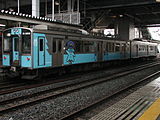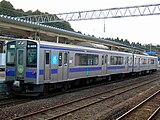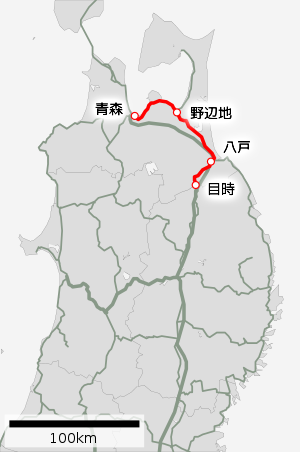| Aoimori Railway Line | |||
|---|---|---|---|
 Aoimori Railway 701 series EMU in September 2010 Aoimori Railway 701 series EMU in September 2010 | |||
| Overview | |||
| Owner | Aomori Prefecture | ||
| Locale | Aomori Prefecture, Japan | ||
| Termini | |||
| Stations | 26 | ||
| Service | |||
| Type | Regional rail | ||
| Operator(s) | |||
| Rolling stock | Aoimori 701 series EMUs Aoimori 703 series EMUs | ||
| History | |||
| Opened | 1 September 1891 (1891-09-01) (As part of the Nippon Railway) 1 December 2002 (2002-12-01) (As the Aoimori Railway Line between Metoki and Hachinohe) 4 December 2010 (2010-12-04) (As the Aoimori Railway Line between Hachinohe and Aomori) | ||
| Technical | |||
| Line length | 121.9 km (75.7 mi) | ||
| Track gauge | 1,067 mm (3 ft 6 in) | ||
| Electrification | 20 kV AC, 50 Hz overhead catenary | ||
| |||
| Aoimori Railway Line | ||||||||||||||||||||||||||||||||||||||||||||||||||||||||||||||||||||||||||||||||||||||||||||||||||||||||||||||||||||||||||||||||||||||||||||||||||||||||||||||||||||||||||||||||||||||||||||||||||||||||||||||||||||||||||||||||||||||||||||||||||||||||||||||||||||||||||||||||||||||||||||||||||||||||||||||||||||||||||||||||||||||||||||||||||||||||||||||||||||||||||||||||||||||||||||||||||||||||||||||||||||||||||||||||||||||||||||||||||||||||||||||||||||||||||||||||||
|---|---|---|---|---|---|---|---|---|---|---|---|---|---|---|---|---|---|---|---|---|---|---|---|---|---|---|---|---|---|---|---|---|---|---|---|---|---|---|---|---|---|---|---|---|---|---|---|---|---|---|---|---|---|---|---|---|---|---|---|---|---|---|---|---|---|---|---|---|---|---|---|---|---|---|---|---|---|---|---|---|---|---|---|---|---|---|---|---|---|---|---|---|---|---|---|---|---|---|---|---|---|---|---|---|---|---|---|---|---|---|---|---|---|---|---|---|---|---|---|---|---|---|---|---|---|---|---|---|---|---|---|---|---|---|---|---|---|---|---|---|---|---|---|---|---|---|---|---|---|---|---|---|---|---|---|---|---|---|---|---|---|---|---|---|---|---|---|---|---|---|---|---|---|---|---|---|---|---|---|---|---|---|---|---|---|---|---|---|---|---|---|---|---|---|---|---|---|---|---|---|---|---|---|---|---|---|---|---|---|---|---|---|---|---|---|---|---|---|---|---|---|---|---|---|---|---|---|---|---|---|---|---|---|---|---|---|---|---|---|---|---|---|---|---|---|---|---|---|---|---|---|---|---|---|---|---|---|---|---|---|---|---|---|---|---|---|---|---|---|---|---|---|---|---|---|---|---|---|---|---|---|---|---|---|---|---|---|---|---|---|---|---|---|---|---|---|---|---|---|---|---|---|---|---|---|---|---|---|---|---|---|---|---|---|---|---|---|---|---|---|---|---|---|---|---|---|---|---|---|---|---|---|---|---|---|---|---|---|---|---|---|---|---|---|---|---|---|---|---|---|---|---|---|---|---|---|---|---|---|---|---|---|---|---|---|---|---|---|---|---|---|---|---|---|---|---|---|---|---|---|---|---|---|---|---|---|---|---|---|---|---|---|---|---|---|---|---|---|---|---|---|---|---|---|---|---|---|---|---|---|---|---|---|---|---|---|---|---|---|---|---|---|---|---|---|---|---|---|---|---|---|---|---|---|---|---|---|---|---|---|---|---|---|---|---|---|---|---|---|---|---|---|---|---|---|---|---|---|---|---|---|---|---|---|---|---|
| Legend | ||||||||||||||||||||||||||||||||||||||||||||||||||||||||||||||||||||||||||||||||||||||||||||||||||||||||||||||||||||||||||||||||||||||||||||||||||||||||||||||||||||||||||||||||||||||||||||||||||||||||||||||||||||||||||||||||||||||||||||||||||||||||||||||||||||||||||||||||||||||||||||||||||||||||||||||||||||||||||||||||||||||||||||||||||||||||||||||||||||||||||||||||||||||||||||||||||||||||||||||||||||||||||||||||||||||||||||||||||||||||||||||||||||||||||||||||||
| ||||||||||||||||||||||||||||||||||||||||||||||||||||||||||||||||||||||||||||||||||||||||||||||||||||||||||||||||||||||||||||||||||||||||||||||||||||||||||||||||||||||||||||||||||||||||||||||||||||||||||||||||||||||||||||||||||||||||||||||||||||||||||||||||||||||||||||||||||||||||||||||||||||||||||||||||||||||||||||||||||||||||||||||||||||||||||||||||||||||||||||||||||||||||||||||||||||||||||||||||||||||||||||||||||||||||||||||||||||||||||||||||||||||||||||||||||
The Aoimori Railway Line (青い森鉄道線, Aoimori Tetsudō-sen) is a regional rail line in Aomori Prefecture, Japan that is operated by the Aoimori Railway Company. It connects the terminal station of the Iwate Galaxy Railway Line, Metoki Station, in the town of Sannohe to Aomori Station, the terminus of several rail lines in the city of Aomori. The Aoimori and Iwate Galaxy Railway Lines are former sections of the Tōhoku Main Line that connected Tokyo to Aomori that were rendered obsolete for long-distance passenger services by the completion of the high-speed Tōhoku Shinkansen between Tokyo and Shin-Aomori stations. Though local passenger services are run on the line by the Aoimori Railway Company, the East Japan Railway Company continues to operate limited services, such as the sightseeing train Resort Asunaro, along the line, and the Japan Freight Railway Company (which owns a minority stake on the Aoimori Railway Company) transports freight along the line.
History
See also: Tōhoku Main LineThe predecessor to the Aoimori Railway Line was completed as the Metoki–Aomori portion of the Nippon Railway on 1 September 1891. When the Nippon Railway was nationalized on 1 November 1906, it became part of the Japanese National Railways (JNR) system and was designated part of the Tōhoku Main Line on 12 October 1909. With the privatization and dissolution of JNR on 1 April 1987, the line came under the control of the East Japan Railway Company (JR East).
On 1 December 2002, with the opening of the Tōhoku Shinkansen, the portion of the Tōhoku Main Line located in Iwate Prefecture became the Iwate Galaxy Railway Line, and the portion in Aomori Prefecture from the Iwate border to Hachinohe Station became the Aoimori Railway Line. With the opening of the Tōhoku Shinkansen extension to Shin-Aomori on 4 December 2010, the Tōhoku Main Line tracks between Hachinohe and Aomori were transferred from JR East to the Aoimori Railway Company, resulting in the completion of the Aoimori Railway Line.
There have been a few new developments along the line since its transfer to the Aoimori Railway Company. On 12 March 2012, Nonai Station was relocated 1.5 kilometers (0.93 mi) southwest of its original location. Tsutsui Station, near Aomori High School, was opened on 15 March 2014. Two-car Aoimori 703 series sets began operations on the line on the same day to handle the increased loads presented by the opening of Tsutsui Station.
Organization
The Aoimori Railway Line is operated by the Aoimori Railway Company, a "third-sector" publicly and privately owned company. The railway facilities and tracks are owned by the prefectural government of Aomori as a "Category 3 Railway Business" under the Railway Business Act of Japan. The Aoimori Railway Company leases these facilities from the prefectural government and is responsible for operation of passenger trains on the tracks. This scheme is intended to mitigate the company's burden as an owner of fixed assets and is known as "track/service separation" (上下分離方式, jōge bunri hōshiki).
The Aoimori Railway Line is designated as the rail line between Aomori and Metoki stations that was formerly the northernmost section of the Tōhoku Main Line. Trains operated by the Aoimori Railway Company primarily operate between Aomori and Hachinohe stations; however, some of the railway's trains continue south beyond Hachinohe to Sannohe Station, with fewer continuing south to Morioka Station. Some of the trains that run along the railway between Hachinohe and Metoki Station are carried by the rolling stock of the Iwate Galaxy Railway Company, the operator of the former Tōhoku Main Line between Metoki and Morioka stations.
Japan Freight Railway Company (JR Freight), the nationwide freight train operator, continues to use the line for freight services. For maintenance work, the line relies on the services of the Hachinohe Rinkai Railway Company. As of January 2021, the only JR East limited express operate along the line is the Resort Asunaro sightseeing train that runs between Hachinohe and Ōminato stations, using the line between Hachinohe and Noheji.
Station list
| Station | Japanese | Distance (km) | Shimokita | Transfers | Location | ||
|---|---|---|---|---|---|---|---|
| Between stations |
Total | ||||||
| Metoki | 目時 | - | 0.0 | Iwate Galaxy Railway Line | Sannohe | Aomori | |
| Sannohe | 三戸 | 5.5 | 5.5 | Nanbu | |||
| Suwanotaira | 諏訪ノ平 | 4.0 | 9.5 | ||||
| Kenyoshi | 剣吉 | 5.3 | 14.8 | ||||
| Tomabechi | 苫米地 | 3.4 | 18.2 | ||||
| Kitatakaiwa | 北高岩 | 2.8 | 21.0 | Hachinohe | |||
| Hachinohe | 八戸 | 4.9 | 25.9 | ● | Tōhoku Shinkansen, Hachinohe Line | ||
| Mutsu-Ichikawa | 陸奥市川 | 6.9 | 32.8 | | | |||
| Shimoda | 下田 | 4.2 | 37.0 | ● | Oirase | ||
| Mukaiyama | 向山 | 5.2 | 42.2 | | | |||
| Misawa | 三沢 | 4.7 | 46.9 | ● | Misawa | ||
| Kogawara | 小川原 | 6.6 | 53.5 | | | Tōhoku | ||
| Kamikitachō | 上北町 | 3.9 | 57.4 | ● | |||
| Ottomo | 乙供 | 6.9 | 64.3 | | | |||
| Chibiki | 千曳 | 6.6 | 70.9 | | | |||
| Noheji | 野辺地 | 6.4 | 77.3 | ● | Ōminato Line (Rapid through services) | Noheji | |
| Karibasawa | 狩場沢 | 6.5 | 83.8 | Hiranai | |||
| Shimizugawa | 清水川 | 4.7 | 88.5 | ||||
| Kominato | 小湊 | 6.0 | 94.5 | ||||
| Nishi-Hiranai | 西平内 | 3.8 | 98.3 | ||||
| Asamushi-Onsen | 浅虫温泉 | 6.4 | 104.7 | Aomori | |||
| Nonai | 野内 | 6.5 | 111.2 | ||||
| Yadamae | 矢田前 | 1.5 | 112.7 | ||||
| Koyanagi | 小柳 | 2.0 | 114.7 | ||||
| Higashi-Aomori | 東青森 | 1.4 | 116.1 | ||||
| Tsutsui | 筒井 | 1.4 | 117.5 | ||||
| Aomori | 青森 | 4.4 | 121.9 | Ōu Main Line, Tsugaru Line | |||
Rolling stock and equipment
- Aoimori 701 series 2-car EMUs x9
- Aoimori 703 series 2-car EMUs x2
The Aoimori Railway operates a fleet of 701 series two-car electric multiple units (EMUs). One set was built from new in September 2002, while eight more were transferred from JR East.
Two new two-car Aoimori 703 series EMUs were delivered in November 2013 and introduced from the start of the 15 March 2014 timetable revision.
Rolling stock on the Aoimori Railway Line-
 Aoimori 701 series EMU
Aoimori 701 series EMU
-
 Aoimori 701 series EMU in its initial transitional livery
Aoimori 701 series EMU in its initial transitional livery
-
 The interior of an Aoimori 701 series carriage
The interior of an Aoimori 701 series carriage
-
 Aoimori 703 series EMU
Aoimori 703 series EMU
-
 The interior of an Aoimori 703 series carriage
The interior of an Aoimori 703 series carriage
-
 A JR Freight Class EH500 locomotive hauling freight through Nishi-Hiranai Station
A JR Freight Class EH500 locomotive hauling freight through Nishi-Hiranai Station
-
 A Resort Asunaro HB-E300 series DMU
A Resort Asunaro HB-E300 series DMU
Future plans

The railway has been negotiating with the city of Aomori since December 2015 on a proposal to open a new station between Tsutsui Station and Aomori Station near the point at which the railway passes under Japan National Route 103. The station would be part of a sports arena development for the 2025 National Sports Festival of Japan to be held in Aomori. The neighborhood the station would serve is a primarily residential area, but it would also provide access to some busy shopping centers within walking distance to the station. As of January 2021, no final decision has been made regarding the construction of the new station.
See also
References
- Harris, Ken and Clarke, Jackie. Jane's World Railways 2008-2009. Jane's Information Group (2008). ISBN 0-7106-2861-7
- "駅や築港は国策に翻弄" [Stations and ports are at the mercy of national policy]. Mutsu Shimpō (in Japanese). 9 March 2015. Retrieved 8 April 2021.
- 鐵道國有法 [Railway Nationalization Act] (in Japanese). Japan: Imperial Diet. 1906 – via Wikisource.
- "日本国有鉄道の改革の実施に当たり河川管理上留意すべき事項について" [Matters to be noted in management when implementing the reform of the Japanese National Railways] (in Japanese). Ministry of Land, Infrastructure, Transport and Tourism. 30 March 1987. Retrieved 8 April 2021.
- ^ "青い森鉄道線について" [About the Aoimori Railway Line] (in Japanese). Aoimori Railway Co., Ltd. 2021. Retrieved 8 April 2021.
- "JR東日本 東北本線八戸―青森間の廃止を届出" [JR East announces discontinuation of Tohoku Line between Hachinohe and Aomori]. Tetsudo Hobidas (in Japanese). Japan: Neko Publishing. 27 November 2009. Archived from the original on 16 January 2018. Retrieved 17 October 2013.
- Shuzo, Yui (16 March 2014). "青い森鉄道:初の新駅「筒井駅」開業 新型車両もデビュー" [First new station on Aoimori Railway, Tsutsui, opens. New trains also introduced.]. Mainichi Shimbun (in Japanese). Japan. Archived from the original on 17 March 2014. Retrieved 17 March 2014.
- "地方鉄道の活性化に向けて" [Toward the activation of local railways] (PDF) (in Japanese). Ministry of Land, Infrastructure, Transport and Tourism. 29 March 2013. Retrieved 8 April 2021.
- "Aoimori Railway Line Timetable" (PDF). Aoimori Railway. 14 March 2020. Retrieved 15 February 2021.
- "「わ」の鉄道 青い森鉄道" [Aoimori Railway - A "Wa" Railway]. Japan Railfan Magazine. Vol. 50, no. 595. Japan: Koyusha Co., Ltd. November 2010. pp. 24–29.
- "事業内容" [Business Content] (in Japanese). Hachinohe Rinkai Railway Company. 2015. Retrieved 9 April 2021.
- "Resort Asunaro". JR East. January 2021. Retrieved 11 April 2021.
- JTB Timetable (April 2014) p. 592
- ^ Terada, Hirokazu (October 2014). 新幹線並行在来線 [Conventional railways running parallel with shinkansen lines]. Japan Railfan Magazine (in Japanese). Vol. 54, no. 642. Japan: Koyusha Co., Ltd. p. 71.
- "⻘森 操車場跡地利用計画" [Plan for the utilization of the Aomori Rail Yard] (PDF) (in Japanese). City of Aomori. March 2019. Retrieved 31 March 2021.
- "旧操車場跡地利用 有識者が会議" [Experts meet to discuss the need for a station at site]. NHK (in Japanese). 17 January 2019. Archived from the original on 17 January 2019. Retrieved 18 January 2019.
- "青い森セントラルパーク付近への新駅設置について" [Concerning the establishment of a new station near the Aoimori Central Park] (in Japanese). 10 March 2016. Archived from the original on 19 January 2019. Retrieved 18 November 2020.
- "青森操車場跡地に開業予定の新駅への青い森鉄道本社の移転について" [About the relocation of the Aoimori Railway Headquarters to the new station scheduled to open on the site of the Aomori Rail Yard]. Aomori Prefecture. 13 January 2021. Retrieved 31 March 2021.
External links
- Official website
 (Note: site is geoblocked for some countries including Australia: "Reason: Blocked country: Australia The connection was denied because this country is blocked in the Geolocation settings").
(Note: site is geoblocked for some countries including Australia: "Reason: Blocked country: Australia The connection was denied because this country is blocked in the Geolocation settings").
| Parallel Conventional Lines of Seibi Shinkansen | |||||
|---|---|---|---|---|---|
| of Hokuriku Shinkansen (JR East/JR West) |
| ||||
| of Tōhoku Shinkansen (JR East) |
| ||||
| of Kyushu Shinkansen (JR Kyushu) |
| ||||
| of Hokkaido Shinkansen (JR Hokkaido) |
| ||||
| section in parentheses has railway abandoned | |||||
| Transit in Aomori | |
|---|---|
| Shinkansen | |
| |
| Other railways |
|
| Terminals | |
| Public Ferries |
|
| |
| Aerial lifts | |
| Miscellaneous |
|
